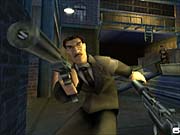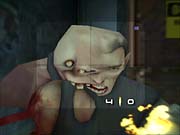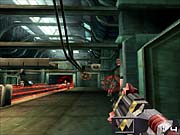TimeSplitters 2 Preview
We visit Eidos, and get a new look at this upcoming FPS.

We've said before without hesitation that TimeSplitters 2, which is being developed by Free Rad and will be published by Eidos, is the best-looking first-person shooter currently in development for the PS2. A recent look we were given at the game has reaffirmed this quite strongly, and it also left us feeling that it is, on top of that, quite possibly the most interesting. We were shown some recent builds of a pair of the game's levels, and each one looked quite slick, graphically, and seemed very well thought out from a design standpoint. Both were fairly quite different from one another from a visual standpoint, which made the unique props in each all the more impressive. TimeSplitters 2 will clearly be a huge game, and, if everything in it ends up as tight as what we've already seen, it's definitely going to get quite a bit of attention.
Understanding the game's basic premise is essential to grasping how huge it has the potential to be. Basically, you assume the role of a pair of time-traveling heroes who hop from era to era in chase of a group of aliens who are devious in some way. The chase will entail visiting periods like the American Old West, 1930s gangster-film-style Chicago, and, of course, the space age, complete with rockets and laser guns. You'll find some pretty clever and elaborate gags, to boot--one of the game's stages, for instance, is set in a Cold War-era Soviet base in Siberia, and it features more than a couple of smug references to GoldenEye. Each of these levels, according to Eidos, is also supposed to boast unique interface art, which would be icing on the cake. All this is especially impressive when you consider that the game's predecessor was a fairly bare-bones affair in the single-player department. All we know so far about this one's multiplayer mode is that it will support i-Link connections, which could be quite cool, provided the options are fairly robust. But given the original's multiplayer-focused nature, we're feeling pretty good about this. Add the game's map editor (which will purportedly be beefed up) to the package, and it's pretty easy to get excited.

Anyway, what we saw recently were two of the game's stages, one of which was a touched-up version of one we've already reported on. The new stage we saw is the one that takes place in 1930s Chicago, which was rendered in suitably dim and moody tones. The story elements are sparsely scripted at this point, but the basic gist of it is that you have to prevent a certain gangland hit from occurring. Doing so, of course, will more or less involve running and shooting people in an urban environment. You spawn quietly on the observation deck of a docked boat, with a bunch of thugs lurking below. You have to make it through them, armed with a silenced peashooter, so you can burst (or creep) through a building and then emerge on the next block, where you'll make an essential rendezvous by phone before being assailed by an escaping gangster and his goons from the window of their car. Provided you take out their tires in time to make them crash, you'll then have a chance to meet your contact in person. He'll direct you to the bar across the street, in which the quiet hit is in the process of escalating into firefight. It becomes your obligation to contribute to this. The reward you get after everyone is dead is quite neat, though--it's the billiards table in the parlor of the bar, and you can use your gun to literally shoot a game of pool with the balls on it.

The game's physics system--evidence of which we saw in the blastable melons in earlier demos--seems to be fully kicking at this point. The game of pool you can play seems regulated by convincing physical forces, as did a host of other gameworld elements. The tops of the fire hydrants you find in the Chicago stage, for instance, will surf the edges of the waterspouts created when you blast them off. Little touches like these permeate every stage we've seen, and it does a lot to liven up the environments and make them all feel very unique.
The second stage we saw, in any event, was a highly touched-up version of the Siberia stage that we extensively played through for an earlier preview. The most noticeable addition to this stage did much to show off the game's particle system: an environmental snow effect used for the areas outside the compound. Light flakes were falling, many of which would land on and slightly blur the game's camera. The effect is quite nice, and it adds quite a bit to the stage's tense, chilly mood. Aside from this, though, the stage seemed largely identical to the one we played before. It involves disabling communications systems with timed mines, sniping people, and a good dose of tunnel running, and it culminates with an encounter with some lumbering zombies. In this build, we were able to shoot the zombies' limbs off, though doing so would only encourage them to pummel you with their limbless stubs for surprising amounts of damage. Included in the mix are sniper rifles, handguns, assault rifle/grenade launcher combos, and satisfyingly enough, flamethrowers. Things and creatures you set on fire can in turn set you on fire through contact, so you'll have to be careful where you step once things are lit. If you find some water, though--via a shower, a spouting hydrant, or what have you--you'll be able to put yourself out. According to Eidos, water sources will be amply spread throughout each level, so you can count on being able to freely use the flamethrower.
As you've probably assumed, the game still looks great. Everything is running at a consistent 60fps, and the frame rate very seldom stutters, AI and particle effects notwithstanding. We did stumble upon some unoptimized stretches in the some of the stages, though the accompanying stutters were never more than a second long. The lighting was very effectively applied, and it was also pretty elaborate, in many cases--the Chicago stage especially. The particle systems were also in full effect--from the spouting liquids to the dancing flames and the spark-heavy assault-rile discharge, it all looked great. The textures are also surprisingly good looking, though some low-res stuff is still present. It's definitely more noticeable in some areas than others, though, and Free Rad's smart use of solid colors, combined with the neat lighting, does a good job of working around the PS2's limitations.
If you haven't already noticed, we're pretty excited about this one. It looks great, moves wonderfully smoothly, and seems as deep and feature-packed as the best console first-person shooters, if not more so. We'll definitely have more on this one for you very soon, so keep your eyes on this space.
Got a news tip or want to contact us directly? Email news@gamespot.com
Join the conversation